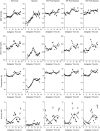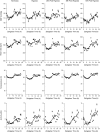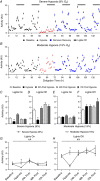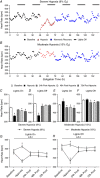Moderate and severe hypoxia elicit divergent effects on cardiovascular function and physiological rhythms
- PMID: 29604069
- PMCID: PMC6068225
- DOI: 10.1113/JP275945
Moderate and severe hypoxia elicit divergent effects on cardiovascular function and physiological rhythms
Abstract
Key points: In the present study, we provide evidence for divergent physiological responses to moderate compared to severe hypoxia, addressing an important knowledge gap related to severity, duration and after-effects of hypoxia encountered in cardiopulmonary situations. The physiological responses to moderate and severe hypoxia were not proportional, linear or concurrent with the time-of-day. Hypoxia elicited severity-dependent physiological responses that either persisted or fluctuated throughout normoxic recovery. The physiological basis for these distinct cardiovascular responses implicates a shift in the sympathovagal set point and probably not molecular changes at the artery resulting from hypoxic stress.
Abstract: Hypoxia is both a consequence and cause of many acute and chronic diseases. Severe hypoxia causes hypertension with cardiovascular sequelae; however, the rare studies using moderate severities of hypoxia indicate that it can be beneficial, suggesting that hypoxia may not always be detrimental. Comparisons between studies are difficult because of the varied classifications of hypoxic severities, methods of delivery and use of anaesthetics. Thus, to investigate the long-term effects of moderate hypoxia on cardiovascular health, radiotelemetry was used to obtain in vivo physiological measurements in unanaesthetized mice during 24 h of either moderate or severe hypoxia, followed by 72 h of normoxic recovery. Systolic blood pressure was decreased during recovery following moderate hypoxia but increased following severe hypoxia. Moderate and severe hypoxia increased haeme oxygenase-1 expression during recovery, suggesting parity in hypoxic stress at the level of the artery. Severe but not moderate hypoxia increased the low/high frequency ratio of heart rate variability 72 h post-hypoxia, indicating a shift in sympathovagal balance. Moderate hypoxia dampened the amplitude of circadian rhythm, whereas severe disrupted rhythm during the entire insult, with perturbations persisting throughout normoxic recovery. Thus, hypoxic severity differentially regulates circadian blood pressure.
Keywords: Blood Pressure; Heart Rate Variability; Telemetry.
© 2018 The Authors. The Journal of Physiology © 2018 The Physiological Society.
Figures









References
-
- Allwood MA, Kinobe RT, Ballantyne L, Romanova N, Melo LG, Ward CA, Brunt KR & Simpson JA (2014). Heme oxygenase‐1 overexpression exacerbates heart failure with aging and pressure overload but is protective against isoproterenol‐induced cardiomyopathy in mice. Cardiovasc Pathol 23, 231–237. - PubMed
-
- Bruno RM, Cogo A, Ghiadoni L, Duo E, Pomidori L, Sharma R, Thapa GB, Basnyat B, Bartesaghi M, Picano E, Sicari R, Taddei S & Pratali L (2014). Cardiovascular function in healthy Himalayan high‐altitude dwellers. Atherosclerosis 236, 47–53. - PubMed
-
- Campen MJ, Shimoda LA & O'Donnell CP (2005). Acute and chronic cardiovascular effects of intermittent hypoxia in C57BL/6J mice. J Appl Physiol 99, 2028–2035. - PubMed
Publication types
MeSH terms
Grants and funding
- S13 SI 0592/Heart and Stroke Foundation of Canada/International
- RGPIN-2015-06019/Gouvernement du Canada, Natural Sciences and Engineering Research Council of Canada/International
- RGPIN-2014-05520/Gouvernement du Canada, Natural Sciences and Engineering Research Council of Canada/International
- RGPIN-2012-404915/Gouvernement du Canada, Natural Sciences and Engineering Research Council of Canada/International
- MOP-111159/Gouvernement du Canada, Canadian Institutes of Health Research/International
LinkOut - more resources
Full Text Sources
Other Literature Sources
Miscellaneous

